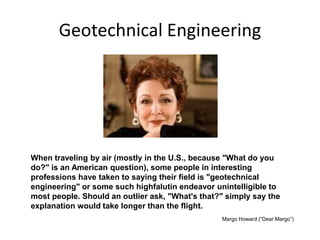Unknown Facts About Geotheta
Unknown Facts About Geotheta
Blog Article
5 Simple Techniques For Geotheta
Table of ContentsThe Geotheta PDFsGeotheta Fundamentals ExplainedAll About GeothetaThe 7-Second Trick For GeothetaExamine This Report about Geotheta

They carry out site investigations, accumulate samples, do lab examinations, and evaluate information to evaluate the viability of the ground for building and construction projects - Consulting Engineers. Based on their searchings for, geotechnical engineers offer recommendations for structure style, incline security, maintaining frameworks, and mitigation of geotechnical hazards. They work together with other professionals, such as engineers, architectural engineers, and construction teams, to guarantee that geotechnical considerations are incorporated into the total project layout and application
By examining the habits and properties of dirt and rock, they can identify possible geotechnical hazards such as landslides, soil negotiation, or incline instability. Their know-how helps protect against failures or accidents that could threaten lives and property. Here are some comprehensive duties and responsibilities of a geotechnical engineer: Website Examination: Geotechnical engineers conduct website investigations to gather data on subsurface conditions.
They translate the information to understand the residential properties and behavior of the soil and rock, including their strength, permeability, compaction characteristics, and groundwater problems. Geotechnical Evaluation and Style: Geotechnical designers evaluate the information collected throughout website investigations to analyze the security and viability of the website for building jobs. They perform geotechnical estimations and modeling to assess aspects such as bearing ability, negotiation, slope stability, lateral earth stress, and groundwater flow.
The smart Trick of Geotheta That Nobody is Talking About
Structure Design: Geotechnical designers play an important function in making foundations that can safely support the intended framework. They examine the dirt problems and load needs to determine the ideal foundation kind, such as superficial foundations (e.g., grounds), deep foundations (e.g (https://allmyfaves.com/geotheta?tab=Geotheta)., heaps), or specialized techniques like soil improvement. They consider aspects such as negotiation limitations, birthing capacity, and soil-structure communication to create optimum structure layouts
They assess building strategies, monitor website activities, and conduct area evaluations to verify that the design referrals are adhered to. If unanticipated geotechnical concerns emerge, they analyze the circumstance and give referrals for remediation or modifications to the layout. Threat Assessment and Reduction: Geotechnical engineers evaluate geotechnical risks and dangers linked with the job website, such as landslides, liquefaction, or dirt disintegration.

Cooperation and Interaction: Geotechnical engineers function closely with various other specialists associated with a project, such as designers, architectural designers, and building and construction teams. Effective communication and collaboration are crucial to incorporate geotechnical considerations right into the general job style and building process. Geotechnical engineers offer technical expertise, response inquiries, and guarantee that geotechnical demands are met.
The Ultimate Guide To Geotheta
Right here are some kinds of geotechnical engineers: Structure Engineer: Structure designers specialize in developing and examining foundations for frameworks. They analyze the soil conditions, lots needs, and website characteristics to establish the most appropriate foundation kind and design, such as shallow foundations, deep foundations, or specialized techniques like heap foundations.
They review the factors influencing incline security, such as soil residential or commercial properties, groundwater problems, and incline geometry, and develop approaches to stop incline failings and mitigate threats. Quake Designer: Earthquake engineers specialize in examining and designing structures to withstand seismic pressures. They assess the seismic threat of a site, evaluate dirt liquefaction capacity, and click for source establish seismic style requirements to ensure the safety and strength of structures throughout earthquakes.
They perform area testing, collect samples, and evaluate the collected data to identify the dirt properties, geologic formations, and groundwater conditions at a site. Geotechnical Instrumentation Engineer: Geotechnical instrumentation engineers concentrate on monitoring and determining the behavior of dirt, rock, and frameworks. They set up and preserve instrumentation systems that keep an eye on variables such as soil negotiation, groundwater degrees, slope motions, and structural displacements to evaluate efficiency and provide very early cautions of prospective problems.
The Of Geotheta
They perform examinations such as triaxial tests, combination tests, straight shear examinations, and leaks in the structure examinations to collect information for geotechnical analysis and design. Geosynthetics Engineer: Geosynthetics engineers specialize in the layout and application of geosynthetic materials, such as geotextiles, geogrids, and geomembranes. They use these products to enhance dirt stability, strengthen inclines, offer drain options, and control erosion.
They have a tendency to be investigatory people, which means they're intellectual, reflective, and curious. They are interested, methodical, rational, logical, and sensible. A few of them are also social, implying they're kind, charitable, participating, person, caring, useful, understanding, tactful, and friendly. Does this seem like you? Take our free occupation test to discover if geotechnical designer is among your leading profession matches.
In the workplace atmosphere, geotechnical designers utilize specialized software tools to carry out estimations, create styles, and assess data. They prepare records, review project specs, interact with customers and staff member, and coordinate job activities. The office setup offers a helpful atmosphere for research, analysis, and cooperation with various other professionals included in the task.
The Main Principles Of Geotheta
They frequently visit project websites to carry out website examinations, examine geotechnical problems, and collect data for evaluation. These gos to include taking a trip to various places, often in remote or difficult surfaces. Geotechnical engineers may carry out soil sampling, conduct examinations, and display building activities to guarantee that the geotechnical elements of the task are being applied appropriately.
Geotechnical engineers also function in specialized geotechnical labs. Geotechnical lab engineers work extensively in these atmospheres, taking care of screening devices, running tools, and recording information.
Report this page